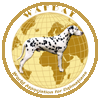



 _
_ select language
select language
sitemap

Dalmatian & Russian Toy Volshebny Mir Kennel / Article
FCI-Standard N∞ 352 / 05.12.2017
Russkiy Toy
(Russian Toy)
TRANSLATION: Anna Samsonova. Edited by Dr. Eugene Yerusalimsky.
ORIGIN: Russia.
DATE OF PUBLICATION OF THE OFFICIAL VALID STANDARD: 07.11.2017.
UTILIZATION: Companion Dog.
FCI-CLASSIFICATION: Group 9 Companion and Toy dogs. Section 9 Continental Toy Spaniels and Russian Toys. Without working trial.
BRIEF HISTORICAL SUMMARY: At the beginning of the 20th century, the English Toy Terrier was one of the most popular toy dogs in Russia. However, in the period 1920 Ц 1950 the breeding of pure toy terriers was almost stopped and the number of dogs fell to a critical level. Only in the mid-fifties did Russian dog-breeders begin the revival of the breed. Practically all dogs which were used for breeding had no pedigrees; many of them were not pure blood. The Standard drafted for Toy Terriers significantly differed from that of the English Toy Terrier in many aspects. From this moment, the evolution of the breed in Russia went its own way. On the 12th of October, 1958 two smooth-haired dogs, one of which had slightly longer hair, gave birth to a male dog with a spectacular fringes on ears and limbs. It was decided to keep this feature. The male was mated with a female which also had slightly long hair. Thus the longhaired variety of the Russian Toy appeared. It was called Moscow Longhaired Toy Terrier. A dog breeder from Moscow, Yevgueniya Fominichna Zharova, played an important role in the creation of this breed variant. It was during a long period of development, in an isolated context, along with a specifically conducted selection that a new breed was created : the Russian Toy with two coat varieties: longhaired and smooth-haired.
GENERAL APPEARANCE: A small, elegant longlegged dog, with fine bone and lean muscles. Very harmonic dog of good proportions. Sexual dimorphism only slightly defined. IMPORTANT PROPORTIONS: The length of the body is equal to the height at withers. The height at elbows is only slightly more than half of the height at withers. The chest reaches the elbows. The length of the muzzle is shorter than the length of the skull.
BEHAVIOUR/TEMPERAMENT: Active, very cheerful, neither cowardly nor aggressive. Always curious of the outer world, strongly devoted to its owner.
HEAD: Small compared to the body. Light, lean; wedge-shaped if viewed from above; occiput is not pronounced. CRANIAL REGION: Skull: High but not too wide (width at the level of zygomatic arches does not exceed the depth of the skull), with a slightly rounded forehead. The roundness should be pronounced but not exaggerated. Stop: Clearly pronounced, of medium depth.
FACIAL REGION: Nose: Small, well developed with well-open nostrils; black or matching the coat colour. Muzzle: Lean and pointed, gradually narrowing to the nose; shorter than the skull: from 1/3 up to 2/5 of the head. Straight nasal bridge. Lips: Thin, lean, tight- fitting and dark or matching the coat colour. Jaws/Teeth: Scissor bite. Level bite extending to 2 or 3 pairs of incisors is permitted but undesirable. Teeth white, of medium size. Cheekbones: Flat, only slightly pronounced. Eyes: Quite large, rounded, expressive, well apart and looking straight ahead. As dark as possible. Eyelids are dark or matching the coat colour, tightly fitting. The look is self-interested, clever, curious, friendly, and intelligent.
Ears: Big, thin, set high, erect, shaped as a high isosceles triangle; set slightly upward. In longhaired variety may be slightly directed sidewards.
NECK: Long, lean, carried high.
BODY
Topline: Moderately and gradually sloping from the withers down to the tailset. Withers: Slightly pronounced. Back: Strong and straight. Loin: Short, sufficiently muscled and slightly prominent. Croup: The croup is sloping at about 15 degree to the horizontal line, of medium width, sufficiently long. Chest: The chest reaches the elbows; of slightly flat oval, shaped in cross-section. Underline: Tucked up belly and drawn up flanks, forming a smooth and nicely curved line from the chest to the flanks.
TAIL: Medium length, sickle or sabre, without wring or kinks. Set moderately high. In movement is desirable to be carried neither lower than back level not lie on the back. Docked tail is permitted; 2 Ц 4 vertebrae are left.
LIMBS
FOREQUARTERS: General appearance: Seen from the front, the front legs are straight and parallel. Set under the body when viewed from the side. The height at elbows is only slightly more than half of the height at withers. Shoulders: The shoulder blades are moderately long and not too sloping.
Upper arm: The length of upper arm is approximately equal to the length of shoulder blade; forms an angle of 100-110 degrees with the shoulder. Elbows: Set rearward. Forearm: Long, straight. Carpus (Wrist): Lean. Metacarpus (Pastern): Straight when viewed from the front. Almost vertical when viewed from the side. Forefeet: Small, oval, turning neither in nor out. Toes well-knit and arched. Pads are springy. Nails and pads are black or matching the coat colour.
HINDQUARTERS: General appearance: Seen from the rear, the hind legs are straight and parallel, standing a little bit wider than the forelegs. Viewed from the side set slightly rearward.
Stifles and hocks are sufficiently bent, in balance with the forelegs angulation.
Upper thigh: Moderately long; muscles are lean and developed.
Lower thigh: Of approximately same length as the upper thighs.
Hock: Of moderate angulation.
Metatarsus (Rear pastern): Perpendicular to the ground and parallel to each other.
Hind feet: The paws are arched and well-closed, a little bit narrower than forefeet; toes are close-cupped, not turned in or out. Nails and pads are black or matching the coat colour.
GAIT/MOVEMENT: Easy, straightforward, light, energetic, moderately reach. The topline is straight; no noticeable change in the topline when moving; somewhat high in withers is permissible. Head proudly held high, tail carried high enough.
SKIN: Thin and tight-fitting.
COAT
Hair: There are two varieties for the breed: smooth-haired and longhaired.
Х Smooth-haired: Short, close-lying, shiny hair, without undercoat or bald patches.
Х Long-haired: Body and neck are covered with moderately long (3-5 cm), straight or slightly wavy hair, close-lying. Hair on the head and on the front part of limbs is short and close -lying. Distinct feathers on rear side of limbs and the tail. Ears are covered with thick, long hair forming a fringe. In adult dogs the fringe, should completely hide the outer edges and tips of the ears. Body hair should not be tousled or fluffy.
Colour: Black and tan; brown and tan; blue and tan; lilac and tan; red with black, red with blue; red with brown, red with lilac; red; fawn; cream. The colour of the nose matches the main hair colour.
SIZE AND WEIGHT: Height at withers: Dogs and females: 22 Ц 27 cm. Weight: Males and females: up to 3 kg.
Preferable height: 25 cm, preferable weight: 2.3 kg.
FAULTS: Any departure from the foregoing points should be considered a fault and the seriousness with which the fault should be regarded should be in exact proportion to its degree and its effect upon the health and welfare of the dog.
Х Timid behaviour.
Х Height less than 22 cm; height more than 27 cm.
Х Longbodied dog; too much arched loin; steeply sloping croup.
Х Missing 1 or 2 incisors in the upper and/or lower jaw.
Х Semi-erect ears in the long-haired breed variation if not caused by heavy and too thick ear hair.
Х Soft ears in the smooth-haired dogs. Х Weak lower jaw. Х Piked or heavy muzzle; dishfaced or downfaced
Х Inverted elbows, toes-out.
Х Straight in front and rear.
Х Angulations of stifles and hocks excessively pronounced.
Х Low set tail, curled tail, spirally twisted tail, tail laying on the back.
Х Minor bald patches in smooth-haired dogs.
Х Too long, loose or slightly waved body hair in longhaired dogs; tousled of fluffy hair; the absence of ornamental hair on the tail.
Х Small white spots on chest and toes.
Х Tan markings too large or with darkened markings.
DISQUALIFYING FAULTS:
Х Aggressive dog, overly shy dog.
Х Any dog clearly showing physical or behavioural abnormalities shall be disqualified.
Х Overshot, level bite extending to the whole pairs of incisors, undershot. Wry mouth; absence of any canine; absence of more than 2 incisors in either jaw.
Х Lower jaw canines thrust against gums or roof of the upper jaw.
Х Tongue visible constantly when mouth is closed.
Х Open fontanel in dogs over 9 months.
Х Short legged dogs.
Х Overdeveloped and massive chest.
Х Semi-pricked ears in smooth-haired dogs.
Х Dropped ears in long-haired dogs.
Х In smooth-haired dogs: numerous bald patches (more than 25 %); very soft, tousled, loose body hair; too long hair with pronounced feathering on limbs and tail; trimmed coat.
Х In long-haired dogs: absence of fringes on ears and, presence of curly hair. , trimmed coat on the body; curly coat; semipricked ears without fringes.
Х Wringed or kinked tail.
Х White spots on the head, on throat, above metacarpus; (pasterns) / metatarsus (rear pastern); large white patches on chest presence of brindle markings; any colour is not specified in the standard.
Х Size over 29 cm or less 18 cm.
Х Weight more than 3 kg or less than 1.5 kg.
N.B.:
Х Male animals should have two apparently normal testicles fully descended into the scrotum.
Х Only functionally and clinically healthy dogs, with breed typical conformation, should be used for breeding.
Main|News|Dog Shows|Our dogs|Puppies|Graduates|Fotos|Article|Contact|Links
FCI kennel "Volshebny Mir"®
© 2010-2018 Volshebny Mir WEB-Design: Evgeniya ShamrayWhen using materials from the site, a link to the resource required